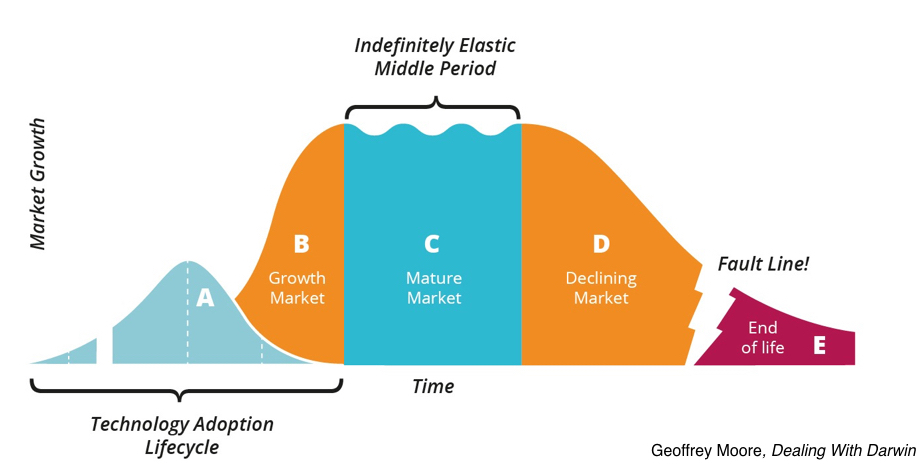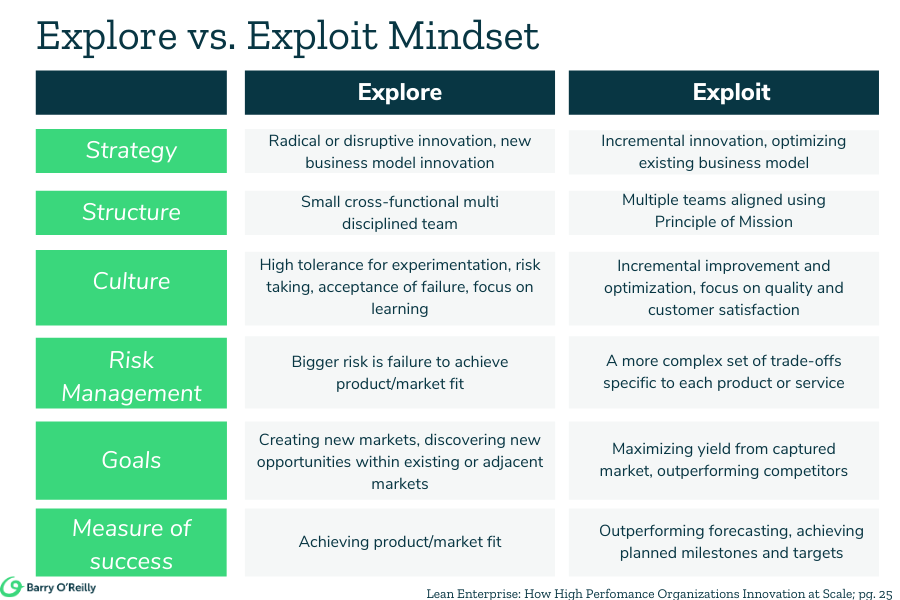The challenge for organizations today is growing the capability to continually adapt, adjust and innovate in the face of uncertainty.
To be successful in an ever accelerating environment, organizations need to make continuous innovation a deliberate practice—integrated into the fabric of the organization and leadership mindset. For high performance organizations, this begins and ends at their portfolio.
In the last half century the average lifespan of a company listed in the S&P 500 Index of leading US companies has decreased by more than 50 years, from 67 years to just 15 years today. Professor Richard Foster from Yale University estimates that by 2020, more than three-quarters of the S&P 500 will be companies we have not heard of yet.
Since 2002, Google, Amazon, and Netflix have joined the S&P 500, while Kodak, RadioShack, Palm and Compaq have all been forced off—accelerated by shift in technology and customer demand. General Electric was the only company that remained on the S&P Index since it started in 1926, yet in June 2018 they too fell foul of failing to evolve.
Future Focused Or Future Fear
In the future two types of organizations will remain. Those that continue ‘as is’, sustaining a solitary business model or product fit for that specific market. Their strategy will be efficiency and optimization to harvest as much profit as possible for a 5-10 year horizon. The trade-off will be their inability to adapt to change. When the industry shifts, their business will slowly collapse.

In contrast, high performance organizations—that embrace Lean Enterprise principles—are designed to operate in an environment of continual change and on-going evolution. They develop the capability to adapt and evolve to meet new market opportunities and threats as they arise.
Leading organizations will survive for longer because their structure, strategies and processes support the continual search for new business models, products and services. Once identified they rapidly maximize and scale opportunities while embracing the creative destruction of their existing portfolio before another competitor does.
Explore and Exploit: Two Competing Organizational Dynamics
Almost by definition, an enterprise’s primary business model is based on well-known set of product or services offerings. Existing business models have been proven, and the domain in which they exist well-understood.
The primary role of business functions is to execute these business models, with the goal of incrementally improving efficiency over time to out-compete the competition. Plans, processes and measures of success can be put into place to monitor and optimize the performance and health of the products and services offered. Forecasts are regularly created for capacity, revenue, growth and sales. Targets can be based on deep data sets accumulated and analyzed over time with a reasonable level of confidence.
When operating in the new economy, simply trying to improve existing initiatives and optimize efficiency is not enough to provide long term sustainability. Organizations need to be continually in search of new opportunities to stay relevant.
Explore is a fundamentally different operating environment to Exploit. Organizations need to leverage customer insights, new technologies and emerging trends to unearth future viable business models, products and services to meet new and existing customers demand.
Typically, existing organizational structures, strategies and metrics for executing initiatives simply do not work in an exploratory context. For example, measuring return on investment during the Explore phases makes little sense and provides little insight into the future profitability of the initiative. In Explore, we are investing to reduce the uncertainty of building the wrong thing. In essence, we’re paying for information—gathered from testing with early customers—to inform future investment decisions.
Few new business models or products generate revenue in Explore hence the initiative will fail to measure up against more mature initiatives that are in an Exploit phase or later.

There is also a necessary tension between Explore and Exploit. As Clayton M. Christensen brilliantly captured in The Innovator’s Dilemma, successful enterprises win or lose based on execution and thus tend to squash exploration in favor of harvesting known and understood business models, products or services.
Exploring new opportunities and exploiting existing ones are fundamentally different strategies— requiring different structure, competencies, mindsets and measures of success. It is hard to overemphasize the key point: management practices that are effective in the exploit domain will lead to failure if applied when exploring new opportunities—and vice versa. The differences between to two domains are list below:

Conclusion
A key goal of successful portfolio management in the enterprise is understanding how to balance exploring new business with exploiting proven existing business models—and how to transition businesses successfully between these domains.
Leaders must understand the difference between these domains and be able to design, implement and operationalize the required mindset, strategies and people that govern them. If it’s fallen to the CEO to manage the organization has not built the capability and will struggle to continually evolve.
References
Get in touch to run my Innovation Portfolio Management workshop at your company
Or dig deeper in my international bestseller Lean Enterprise:How High Performance Organization Innovation At Scale

